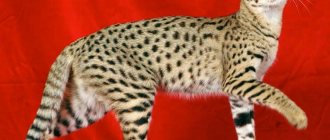Siamese cats have been popular in our country for several decades. In Soviet times, they were considered a symbol of wealth and prosperity. They were purchased by high-level officials, sometimes without even realizing that it was not a Siamese cat that appeared in their house, but its closest relative, a Thai beauty.
Do you know what breed your pet is? The Siamese and Thai cats, the differences of which are obvious to specialists, are sometimes invisible to ordinary animal lovers. Strictly speaking, it doesn’t matter at all what breed your favorite animal belongs to, but as information, we want to introduce you to the differences in appearance and character that exist between these animals.
Origin of rocks
The Siamese cat is a favorite of many around the world. This breed was first bred in Siam. At the same time, not everyone knows that this is a Thai cat, and not a Siamese. Many people confuse the breed, which is due to the double name of the state where the first babies were born. Today Siam is as familiar to everyone as Thailand. It was from this country that four-legged animals were brought to the USA and European countries.
Siamese cat
First, a Thai cat, born in Siam, appeared in the world. To make things easier for themselves, many people began to call the breed based on its place of origin, that is, Siamese. Much later, breeders developed a breed that today everyone knows as Thai.
Thai character
Their character is peaceful and sociable, they expect constant affection and attention. They are also considered to be very intelligent and loyal to their owner. They love to play, by themselves or in company with the owner, it doesn’t matter. Representatives of this breed are very active and curious, which leads to numerous disturbances in the house. Representatives of this breed get along well with other pets in the house, they are very friendly, but for them it is still preferable to communicate and spend time with their owner.
The Thai cat breed is considered open; you can bring your pet to the club to get examined. To determine the breed, the opinion of two experts is enough. This procedure is prohibited with Siamese cats. This cat breed is a closed one.
Gatherings. Cats are very loyal to their owner and do not like to be left alone. But if you want to keep them company, buy a kitten of the same breed group. Orientals have strong, dominant personalities and will overwhelm breeds that are too “soft”, e.g. Oriental and very “chatty” and have a loud voice.
These breeds also have a lot in common in shape and type. These cats are medium-sized, strong, graceful, without signs of excess weight. And at the same time, they must be quite heavy. The head has an elongated shape, with triangular ears. The muzzle is elongated, the nose is straight without humps, the eyes have an oriental slant, but without strabismus.
The main difference between the Oriental breed and the Siamese is the colors. An Oriental cat can have a solid color, while a Siamese can only be a color point color in different color variations. But these variations are limited to cream, red, chocolate shades. The Oriental cat has a single color: white, black, blue, lilac, brown (Havana). There are also cats with patterns on their fur. For example, tortoiseshell color is a mixture of red, cream, and brown. Or the tabby pattern, of which there are more than 30 types - striped, spotted, speckled, etc.
Pay attention to eye color. A true Siamese cat cannot have any color other than blue. In the Oriental, different eye colors are allowed, depending on the color. For example, a white oriental cat may have blue eyes, while a black cat may have bright green eyes. In tortoiseshell and tabby cats, the eye color is the same as the main fur color.
Video on the topic
You will always recognize a miniature Siamese cat: its unique coloring, elongated wedge-shaped head and bright blue eyes distinguish the animal from the diversity of the vast world of cats.
Instructions
Currently, more than forty breeds of Siamese cats are known, with a variety of coat colors: black, marbled, blue, white, tortoiseshell, etc. The uniqueness of the eastern representatives of the cat world is indicated by a special muzzle with a dark “mask”. Their appearance resembles developed creatures that appeared on Earth from outer space.
Once considered a national relic of Thailand, the sacred cat was protected by the law of the country, and taking it out of Siam was strictly prohibited. There are many interesting legends and traditions associated with the Thai cat. Now the Siamese breed is widespread throughout the world, and it first appeared in Great Britain in 1884 as a gift to the consul from the King of Siam.
You may hear that Siamese cats are quite angry and disobedient and can cause trouble for people. The external “aristocratic” appearance of the animal indicates severity and isolation. Of course, Thai beauties have a peculiar obstinate disposition and can show independence. They are proud and freedom-loving, but not aggressive: when disagreeing with a person’s actions, they are able to raise their voice. Siamese are distinguished from other cat breeds by their excellent hunting abilities.
They become very attached to a person, they adore the owner, but they treat those who come to the house with some degree of caution. Most often, Thai cats are peaceful towards children and love to play with them, but children need to be careful: the animal does not tolerate rudeness, even unintentional. Like any other breed, a Siamese cat, surrounded by attention and love, will certainly reciprocate people’s feelings and devotion. She is even capable of rushing to the defense of someone dear to her.
A strong attachment to the owner makes the animal jealous if other pets live in the house. Relationships with dogs are especially difficult.
The independent character of the Siamese helps them to easily endure loneliness during the long absence of their owners. (This breed even needs to be alone from time to time). Great care for her and an affectionate attitude will help to restore sociability to a cat in such a situation.
Like any universe, the world of cat lovers is divided into its own camps: some love the friendly hairless cats, others love the freedom-loving longhaired cats. But among cat lovers there is one “category” whose adherents fall in love once and for all. And the name of this love is the Thai cat breed.
Having once adopted such a pet, lovers of oriental cats no longer take other breeds seriously. Each subsequent choice will remain unchanged - a Thai cat. What is so special about this breed?
The Thai cat is one of the ancient breeds. These animals were first mentioned in manuscripts dating back to the 14th century. In those days, the eastern murka was considered a symbol of prosperity - only noble and wealthy families had the right to live under the same roof with a fluffy Thai woman. Also, representatives of the Thai breed were certainly present at the temple of a Buddhist monk.
Europeans became interested in the exotic breed only in the 19th century, when its representatives were taken from their historical homeland to the big world. Unusual cats instantly gained popularity and became the object of experiments by felinologists. The appearance of the breed gradually changed - the bred cat acquired new features: a wedge-shaped head, large ears and extremely refined limbs. This is how the Siamese breed was formed, leaving the Thai in the shadows - for true lovers of the oriental “classics” of the cat world.
A real Thai cat is considered rare. To confirm that a Murka belongs to the breed, it is necessary to undergo a special examination and many tests. Only after a lengthy procedure and at least two positive expert opinions is the cat added to the ranks of eminent relatives.
To this day, the Thai cat is considered the ancestor of the Siamese; these breeds go hand in hand through history.
How are Thai and Siamese breeds similar?
The Siamese and Thai breeds are noted for their playfulness, curiosity and intelligence. These are the animals that never miss a single interesting event taking place in the family. As for appearance, their color is almost the same. So, on the tail, paws or on the face there may be a purple, gray or black tint. Pets' eyes are either sky blue or blue. The coat color is only light. We can say that these are all similarities. If a person is shown two four-legged animals at the same time, he will forever remember which of them belongs to one breed and which belongs to a completely different one.
Thai cat
Origin
Thai and Siamese cats are Siamese-Oriental cats, but not the same breed. Information about Siamese beauties was found in chronicles dating back to the 14th century. Felinologists consider them to be one of the representatives of purebred breeds created by nature itself.
In Siam, these cats were revered as sacred animals, protecting the peace of temples and protecting the royal family. The Siamese were distinguished by their waywardness, majesty and high intelligence. Due to the specific characteristics of the country, the appearance of their fur coat may vary slightly.
Exotic cats settled around the world when Siam was already called Thailand. This led to a lot of confusion with the name, and often a mixture of Siamese and ordinary cats was passed off as purebred animals.
It is popularly accepted that if cats are relatives of related species and colors, they should be classified as one group. Half-Siamese is any beauty that has a characteristic color with a light body, dark tail and head, and blue eyes.
However, in the 20th century, breeders worked hard to develop a new breed, which was called Thai, and was so loved by the broad masses. The variety of Siamese and Thais is increasing every day.
Standards for both breeds
The characteristics of the breed are the main thing that identifies this or that representative. If there was no crossbreeding, then there are some characteristic nuances that exist in some animal species and in others.
The Thais have them like this:
- Compact body. At the same time, a beautiful and large physique. The weight of some adult animals can be over 8 kg.
- The limbs are of medium length. As for the tail, it is thick and small.
- The head shape of Thai cats is always round. In addition, it is worth noting the profile, which has a concavity at eye level.
- The ears are small and their tips are slightly rounded.
- The eyes are round in shape, expressive and large.
- The coat is smooth, shiny, short and without undercoat.
Siamese have the following:
- The body is flexible, long and slender.
- The limbs are long. The tail is exactly the same.
- The head resembles a wedge. If you look closely, it seems that the tips of the ears and nose together form a rectangle.
- The profile is straight only. The eyes seem to be slightly slanted and almond-shaped.
- The ears are quite wide, pointed at the very base. The ears are the first thing that catches your eye when you see a cat because they are large.
- The fur is smooth and short.
How to distinguish a Siamese kitten from a Thai one?
We have already explained the difference between a Thai and a Siamese cat. The differences are obvious, but they apply only to adult animals. Identification of kittens is somewhat more difficult, because the characteristics typical for the breed by two to three months, when babies usually find their new owners, are not yet fully manifested.
First of all, pay attention to the shape of the skull: Siamese kittens have a wedge-shaped head with large ears and a straight, long nose. Little Thais have round heads. The Siamese's tail is even in thickness along its entire length, while in a representative of the Thai breed it tapers from base to tip.
Siamese cats, even at a young age, have an elongated and thin body and long limbs. Small Thais have a denser build.
How are Thai cats different from Siamese cats?
The differences between the Siamese and Thai cats are obvious.
When you see a Siamese, you pay special attention to his body. Nature has endowed these animals with an elongated and thin body. Representatives of the breed appear longer than all others due to their thin tail. Sometimes it seems that pets are not fed enough, but this is not so. The Thais are a completely different matter: fluffed, large, plush. They appear large even when they are not. This is also an illusion, since this is their body. A thick, but not long tail also helps to enhance the effect. If the Siamese has a thin and elongated muzzle, then the Thai has the opposite - this is one of the most striking key differences. Animals also differ from each other in color. Siamese cats have a light coat, and dark spots can only be seen on the tail, paws and face. As for representatives of Thai individuals, their darkening has different shades, ranging from purple to charcoal.
You might think that quadrupeds have only external differences, but there are also plenty of internal ones. It's about character. Animals are complete opposites in relation to each other. Thus, the Thais are famous for their kindness and relative calmness, which cannot be said about the Siamese. It can be difficult with them sometimes. If a cat wants to show his character, then he will definitely show it.
Important! Breeders note that Siamese, unlike Thais, consider themselves full-fledged masters in the house, who must be taken into account.
Siamese can be taught a lot, but it should be within reason. If a pet gets angry with its owner, it will continue to harm him for a long time. Therefore, before buying an animal, you should think about whether this is really the friend you want to see next to you. Perhaps you should pay attention to the affectionate and devoted Thais. Although everything is individual.
Siamese cats also love their owners and everyone who lives in the same house with them, but they do not show it so clearly. Four-legged animals do not tolerate loneliness well; for them it is tantamount to a test, so it is better not to leave cats alone for a long time. As for Thais, representatives of this breed have a hard time getting used to new people, so it’s especially hard for the “lost” ones.
Reviews about Thai cats
I have a Thai girl, smart, beautiful, a real member of the family. She is very inquisitive, takes part in everything that happens at home, i.e. she is constantly with us. She loves it when they play with her as a teaser, she will bring it in her teeth, put it at her feet and sit, watch or ask with her voice to be played with. He won’t offend without reason, but he will also stand up for himself. My son is 1, she has never scratched him, sometimes she hisses at him, but that’s when she doesn’t want him to touch her. In general, she’s also a good nanny. One day my son burst into tears, so she came running, lay down next to him, and began to purr. The child, of course, began to calm down. He teases her, and she endures. You can talk and talk, and only good things.
Felicia
https://www.u-mama.ru/forum/family/pets/530129/
2 years and 2 months ago I bought a small, thin, ugly, timid kitten from a woman. At that time, the kitten was more than a month old; he didn’t even know how to jump from the sofa. We arrived home, showed the cat a potty, a bowl of food and went to bed with her. At 7.00 in the morning there was a miu, miu! I jumped off, and she was sitting next to me and asking for something. It’s unclear, she decided that she was hungry, brought her to the bowl, and she ran to the potty. Poor child, he endured it and didn’t do anything wrong. Since then, she and I have been inseparable. Every day Milka surprised me in many ways. She always met me when I came home from school, slept on my chest when I was sitting at the computer or TV, rode on my shoulder in the car (I was driving) and curiously looked at the world, rushed around the entire apartment, crashing into walls. She climbed up like a tree and sat on my shoulder while I was preparing food. During the day I slept exclusively on my laptop and carried hair ties. After the game, she put them in her bowl, took pity on me when I cried or was sick, kissed me (she loves to suck on my lower lip), called me to sleep, when I sat too long at the computer, no matter where I was, she was always either on me or next to me. To this day, almost all of her habits have been preserved, except for climbing on me when I’m standing. Kisunya has grown up and has already become a mother twice.
NatellaRevan
https://irecommend.ru/content/istoriya-o-chumazom-schaste-foto-koshki-s-kotyatkami
Today I want to talk about the most wonderful cat breed I know, Thai! For two years now, this blue-eyed miracle, whose name is Woof, has been living with me. Yes, yes, as a child he looked like his prototype from the cartoon, so the nickname somehow became attached to him by itself. Although sometimes his daughter also calls him Gavryusha. What I really like about Thai cats: they are smart, affectionate, with dense short fur, that is, they do not need special care, the hair never mats, as happens with long-haired breeds - playful, - very sociable, - incredibly charming and charismatic . This breed reminds me of the most faithful dog: my Woof understands me at a glance, knows several commands: “Go to mom,” “Eat,” “Get in place,” “Kiss me.” There is never a dull moment with a Thai cat: they come up with their own entertainment, and are very inventive in their games. My blue-eyed baby is involved in all household chores. An interesting fact is that Thai cats, like all other Siamese cats, are born completely white. And only a little later the “darkness” begins to appear. My favorite has a Seal Point color, that is, the body is the color of baked milk, and the muzzle, paws and tail are dark. Thais, like Siamese, are long-lived among cats; my friend’s cat lived to be 26 years old, did not get sick, and in the 27th year one day he simply did not wake up. Gavka loves to kiss and hug. He also shows his mood wonderfully with his facial expressions. Sometimes he steals something from the table, and then “puts on a mask of misunderstanding: his eyes are in a bunch, his mustache is forward, and he has this funny expression on his face, like: “Well, don’t scold me,” you moron!” But in fact, there is no smarter cat in the world!
Lalika
https://otzovik.com/review_2583537.html
Character of the Thai breed
As already mentioned, the main difference between a Thai cat and a Siamese is its character. The animal is distinguished by its gentleness, calmness and intelligence. Pets really like to watch everything that happens around them. There is a real feeling that they are assessing the situation and trying to understand what will happen next. Representatives of the breed become attached to their owners from a young age, so they tolerate separation very hard. The owner's refusal to accept them is a great tragedy. The Lost Ones need more than one month to adapt to their new family and begin to recover from stress.
The gentle nature of the Thai cat allows you to have several animals in the house. Moreover, these can be not only representatives of this breed, but also many others. Pets get along well with decorative rabbits, chinchillas, and dogs.
Important! Thais cannot be alone for a long time; their psyche can be seriously disturbed.
Therefore, if the owners are not at home for days due to business trips, for example, then you should get either another pet, or leave as many toys as possible for the furry so that he does not have to get bored.
Thai cats are one of the kindest cats, so you can safely leave them alone with kids. Animals, even if they play, never release their claws. Tired of the kids, they just get up and walk away.
The peculiarity of the breed is its “talkativeness”. These are almost the only representatives of cats that can make such a variety of sounds. In addition, pets have well-developed facial expressions, from which a caring owner can easily determine what mood the animal is in and what it wants. The appearance of the four-legged animal is inimitable thanks to this nuance.
Sometimes curiosity gets the better of furry creatures too much. Of course, they have a sense of self-preservation, but if something interesting is happening in the house, they will never miss it, even if it is scary.
To accustom a kitten to a potty, a scratch pad, and a place to sleep, you should teach your baby to be tidy from childhood. The animal quickly remembers all the necessary rules and does not break them. Until the age of 4-5, pets are especially active, so you should be prepared for this. Later, age will make itself felt, but from time to time the cat will still remember his younger years with pleasure.
Comparison of two breeds: what are the differences?
Due to their intricate history, cats are often confused with each other, because both the Thai and Siamese breeds come from the same ancestor. Initially, they were considered the same breed, as they are similar in eye color, coat color, and also a mask on the face. But thanks to their different body structure, habits and character, they were nevertheless distinguished into two separate subspecies. Thanks to breeders, there are about 40 breeds of Siamese varieties.
Origin
For the first time, drawings depicting Siamese cats are found in ancient manuscripts, which are still kept in the National Library of Bangkok. Felinologists claim that the homeland of cats is Siam (the modern name is Thailand). In ancient Siam, only kings owned cats; they were protected from prying eyes, believing that they accompanied the souls of the rich to another world. After the funeral, the cat, a participant in the ritual, was sent to the temple, where she lived in prosperity until the end of her days. After all, according to legends, the Siamese was considered sacred and stood up for the soul of the deceased, helping him find peace in another world.
It was from the Siamese that the second breed of pets was bred.
The history of the appearance of these cats in Europe is quite confusing. There is an opinion that kings began to give cats to noble people. In 1870, Siamese were presented at an exhibition in London and were officially registered in 1902. Thai cats are direct relatives of the Siamese, because they were bred by felinologists through selective breeding.
Appearance: similarities and differences
| Part of the body | Breed | |
| Thai | Siamese | |
| Torso | Medium size, strong and slender with a well-developed physique | Graceful, slender and long |
| Neck | Medium to short length, strong and lean | Long and flexible |
| Ears | Small in size: wide at the base, sometimes with small tassels | Large in size, wider at the base and pointed towards the end |
| Eyes | Almond-shaped, bright blue, regular size and widely spaced | Almond-shaped with shades of blue, huge and slanted, but not oblique |
| Limbs | Strong and proportionate to the body with slightly rounded legs | Thin proportional to body length with oval pads |
| Tail | Medium length, wider at the base and pointed towards the end | Long, smooth and elastic |
| Head | Round | Wedge-shaped, without pointed lines on the muzzle |
Color of cats
The fur of such animals may have a blue point color.
A Siamese-Oriental kitten is easy to identify because it is born white. Dark tips on the paws, face and tail appear only with age, and they are called points, this is what distinguishes the breed. Siamese cats are short-haired, with fur that lies tightly to the body, unlike Thai cats, without undercoat. The coat is velvety to the touch, with a distinct contrast between the base color and markings. A distinctive feature of the Siamese breeds is a mask that covers the entire muzzle, but not the upper part of the head. There are differences in Siamese coloration, but many organizations only recognize four of them:
- seal point;
- blue point;
- chocolate point;
- lilac point.
Initially, Thai cats were not supposed to have an undercoat, but it is present in pets bred by Russian breeders.
The typical color of Thai cats is when the face, ears, paws and tip of the tail are dark, and the body is light. Dark sides come in a variety of tones: chocolate, cream and purple. As they grow older, the color becomes darker, and not only on the tips of the paws, tail, ears and muzzle, but also throughout the body. Breeders have bred many shades of Thai color, some of which are very rare. The Thai cat's fur is soft, pleasant and silky, without a pronounced shine.
Behavior
This pet loves its owner very much and enjoys spending time with him.
The originality and difference in the traits of the Siamese and Thai breeds is not only in appearance, but also in character. A sociable and sociable cat is the Siamese. She is so devoted to her owner that she behaves like a dog. Thanks to training, the cat follows simple commands and brings various objects. Siamese have a well-developed level of intelligence, and at the same time they are also very sweet and good-natured. The Siamese cat is easy to distinguish by its loud voice; with its help, it speaks, becomes indignant, or expresses its requests.
The Thai cat has a more reserved and peaceful character, although it is also very smart. Unlike the Siamese, it loves to lie down instead of active games, tolerates the absence of its owner more calmly, but is also very devoted to him. Thais are sociable and friendly, they get along well with all family members, including children and other pets (dogs, hamsters).
Content
The coat of pets of the Siamese-Oriental group is short and smooth and does not require special care. Since cats are afraid of water, they lick themselves and rarely need to be bathed. Feeding is simple for owners. The cat eats natural food, but will not refuse dry food. These cats will make excellent companions for the whole family. But we must forget about silence in the house, as they are very loud and wake up their owners in the morning with loud meows, asking for breakfast or even just when they need attention. With a Siamese cat, you need to take care of training and education; you can teach her to loudly ask for a treat, and the animal will wait patiently.
Appearance
There are about forty varieties of Siamese cats , and each subspecies has some external differences. But still, for all Siamese there is a certain standard. The body of the Siamese cat is flexible, even somewhat thin and emaciated. The tail is long and thin, as are the limbs, and the head is wedge-shaped. If you look at a Siamese cat in profile, you will notice the absence of the “bridge of the nose”; the forehead and nose are on the same straight line. The eyes have a rare color for cats - blue, and an almond-shaped, slightly slanting shape. A distinctive feature of the breed is a dark mask on the face, while Siamese cats themselves are light in color. It is also characteristic of the breed that Siamese kittens are born white, and only by six months do they acquire the coat color characteristic of the breed. The ears of Siamese cats look simply huge when compared to the cat's head.
The color of Thai cats is also interesting: this breed of cat has a mask on the face and limbs of a dark (black, brown, gray and even purple) color. The eye color is blue, the shape is almond-shaped on top, and the lower eyelid is rounded. The head is not wedge-shaped, but rather round. The ears look proportionate to the head, their tips are rounded. The Thai body is muscular, but not elongated. With its entire appearance, a cat conveys strength and flexibility, but not delicacy and fragility. A characteristic feature is that Thais do not have undercoat.
What does a Siamese cat look like?
What does a Siamese cat look like? For its spectacular appearance, this beauty was called the moon diamond. It is easy to recognize a representative of the Siamese breed by its color: with a light body color, the animal has points on the face, ears, paws and tail.
Moreover, kittens are always born of a light, uniform color; dark pigments (points) appear later, closer to 10 months of age.
The appearance of points is associated with temperature differences: it was always warm in the mother’s womb, the temperature remained constant. Therefore, the pigment did not show itself at all. When a kitten is born and grows, there is a temperature difference in different parts of the body: the ears, paws, tail and muzzle have a lower temperature.
Therefore, the pigment appears exactly there. The warmer the house where the Siamese breed lives, the lighter its points will be.
The female Siamese breed is not large; its weight varies between 4-5 kg.
The Siamese cat is graceful and intelligent, and is distinguished by its particularly refined movements and gait.
Thai cat: character and abilities
The Thai cat has an easy-going character. Thais are easy to train and are able to follow some commands (cat training should be done from early childhood).
Thais love their owners and become very attached to them. They differ from other felines in their curiosity and playfulness. Kittens sleep little and are very active, they like to play with each other and with people.
Thai pets purr very beautifully, love to talk, and respond to their owners with expressive sounds and long speech.
By nature, Thais are mousecatchers, so in the house where such a pet lives, the absence of rodents is guaranteed.
Cohabitation with an Oriental Murka
Living next to a Thai cat is not difficult. These pets respect the rules in the house and observe feeding and resting areas. Her exquisite origin and high intelligence will not allow the Thai woman to pass the tray. This clever girl will leave the option with scattered filler to less intelligent animals.
The Thai cat's weakness is jumping. There is no more exciting activity than conquering cabinets and shelves. The cat completely trusts the owner to save things standing on a hill. It was he, the stupid one, who decided to install flower pots where he could climb with pleasure.
What distinguishes the Thai cat from others is its masterly use of its limbs. The cat is able to lift and throw objects with its front paws, and also eat with them as if with its hands.
There is a wonderful trait in the character of the Thai cat - it is attached not to the house, but to the person. This quality allows owners to travel with their pets, and if they need to move, it makes changing their place of residence less painful.
Thai cats are very attached to people. In communicating with him, they find the meaning of their lives, and in the long absence of the owner, they fall into real depression. Cats of this breed should be owned by people who can easily set aside time every day to communicate with their pet. Only in this mode will the Murka feel comfortable and delight its owners in a good mood.
There is an opinion that Thai cats are extremely aggressive. This is partly true. But only in the case when the animal has “mixed blood”, if one of the parents was outbred. Street education rewards cats not only with self-confidence, but also with an evil disposition, which they successfully pass on to their kittens. Purebred Thais have not been tested by a wandering life, so their temperament is soft, fluffy and good-natured.











